4 Sandbag Alternatives & When to Use Each Type
Author: Chris Miller | Editor: Omar Alonso
Review & Research: Jen Worst & Chris Miller
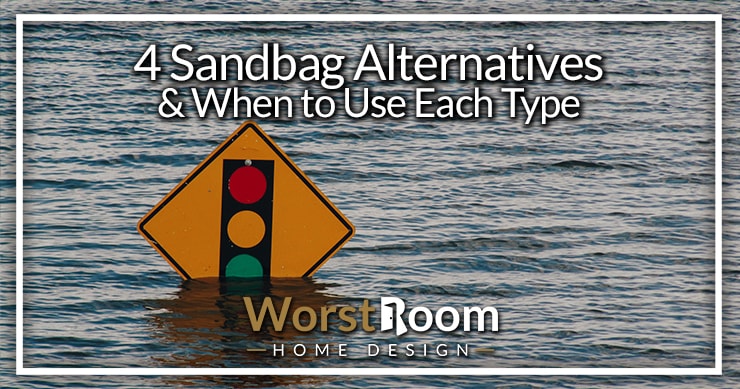
Sandbag alternatives are a go-to way to keep floodwaters away from homes due to the issues with sandbags themselves.
Sandbags are relatively quick and easy to make on short notice, and it doesn’t take a degree to install them. You fill bags up with sand, and then you build a wall with those bags.
The weight of the sand fills in any gaps, and you’ve got pretty decent protection from the flood as long as you’ve got enough sandbags and you get them up in time.
When cities and towns are experiencing floods, it’s not uncommon for the community to get together to sandbag the shores, especially in the yards of houses that are on the river.
Nothing really causes more anxiety for people living near water than a storm or a quick melt in the spring that causes those river waters to slowly but surely rise higher and higher until they’re creeping up on your home.
As much as sandbags can help, they aren’t always available so sometimes you need alternatives to sandbags for flooding, and that’s what we’re going to be learning about today.
We understand that when you’re looking up information about something like this, you might not have any time to waste. This is the type of thing that you usually look for when you already need it so we’re going to get right into it.
If you’ve planning ahead and aren’t in as much of a hurry, give yourself a pat on the back for being proactive. In any case, let’s get right into it…
What To Use Instead of Sandbags: Sandbag Alternatives
Different options will work in different situations. There’s a reason that sandbags have been the default for so long.
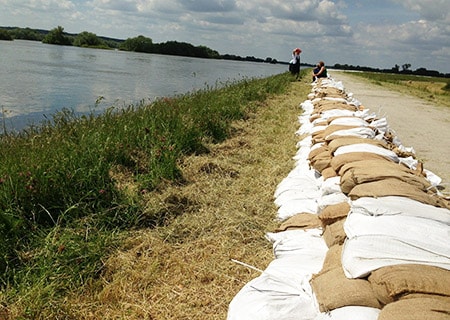
The main reason is that they’re cheap, but they’re also versatile. You can bring a truckload of sand and a box full of bags to whatever location they’re needed, fill them up quickly with a team of volunteers, and get them deployed.
Now, if you’re just dealing with your own home, or a basement leak, the scaleability or affordability of sandbags at a city-wide scale isn’t always your top concern. Check out these sandbag alternatives…
The Hydrabarrier
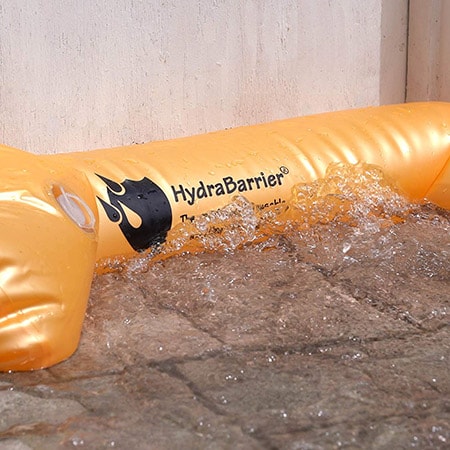
The Hydrabarrier is an eco-friendly alternative to sandbags. It’s quick and easy to use, and comes in a number of different heights. Their standard size offers protection against 4 inches of water, the ultra size protects from six inches of water, their supreme size protects against 12 inches of water, and finally their titan size can protect you from up to 20 inches of water.
One hydrabarrier can replace hundreds of pounds of sandbags. What’s cool about it is that it actually uses water to protect you from water.
It’s essentially a strong plastic tube that you fill with water from your garden hose, and then place it where it’s needed, and it creates a barrier there.
Since it’s heavy and filled with water, it’ll stay in place and it’ll stop water from getting past it for the most part. You can use multiple barriers if you have a longer stretch to protect, and you can choose the size the height/size depending on how vulnerable that area is, and how much water you’re anticipating.
It’s more expensive to get a larger one, but just think of that as an insurance policy in case the flood is worse than you thought it would be. It’s a small price to pay for the extra protection, in my opinion.
Obviously, this wouldn’t really do much for a big flood, which highlights one of the other reasons that sandbags have been the default for so long - they can protect against feet of water, whereas the hydrabarrier can’t protect you from even two feet.
But, in a lot of cases, that’s plenty. This product is great for putting outside of your home if there are problem areas that lead to basement leaks after a heavy rain or a quick snow-melt.
Regarding melting snow, however.. If you’re using the hydrabarrier in cold weather, it’s recommended to only fill it up about 70% because this will give you some room for the water to freeze and expand inside of it.
You can also use an anti-freezing agent, too, and the company that makes it, Watershed Innovations, recommends only doing this if you’re using environmentally friendly anti-freezing agents.
When you’re done, you just remove the cap and empty out the water. It’s oval-shaped, so it’s not very likely to roll around, but if you’re using it on a surface that isn’t flat, this is something to keep in mind.
You can also place something in front of it to stop it from rolling, no problem! Just make sure it’s not something that could puncture if it is under increased pressure. You can learn more about the Hydrabarrier here.
Quick Dam Sandless Sandbags
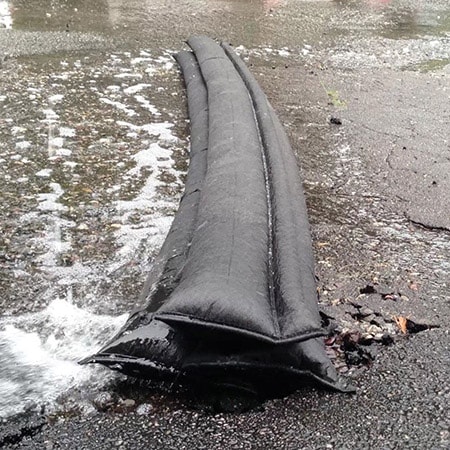
The Quick Dam product is a set of expanding barriers to help keep floodwaters away from whatever you need to protect. This is another type of sandless sandbags, but has a big key distinction from the Hydrabarrier we just looked at.
The similarity is that they’re relatively small, easy to transport, and don’t need sand. A Quick Dam weighs less than one pound.
So, what’s the difference between a Quick Dam and the Hydrabarrier? Well, as we discussed, you need to fill up your Hydrabarrier with water from your garden host. The Quick Dam, on the other hand, is filled with a very special powder that absorbs water.
So, the Quick Dam actually activates itself. It absorbs water, and then the powder inside of it becomes water-logged, which causes the barrier to expand, and allows it to block the flow of water.
This makes them the easiest option to set up and deploy since you don’t need access to running water. In the event of a basement flood, your water supply could already be compromised, but the Quick Dam gets rid of that concern.
The brand Quick Dam makes a number of different products from mats for very minor leaks in the home, to industrial dams that can go into rivers to help divert water as needed. Right now, I’m referring specifically to their sandless sandbag product, just so there’s no confusion.
These flood barriers are sealed when you buy them and will last for about 5 years in storage, but beyond that they do have a shelf life so that’s something to keep in mind.
Also, they will decompose overtime like compost, they’re safe for the environment so you can really just leave it there when you’re done, if you want to.
So, comparing it to the Hydrabarrier, it essentially functions the same way by creating a water-filled barrier to divert water - but one of them gets filled up with a hose and is easy to empty and re-use, whereas the other one absorbs the water directly and expands, and will decompose eventually.
NoFloods FlexWall
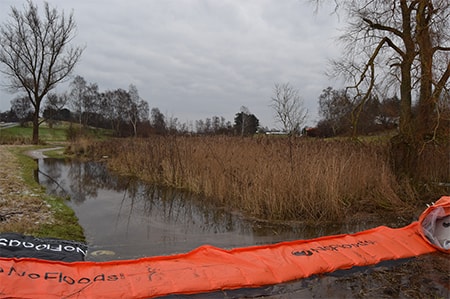
Here’s another approach that functions similarly to the Hydrabarrier and the Quick Dam Sandless Sandbag in some ways, with its own key distinction. The NoFloods Flexwall comes in four different sizes, protecting from about 10 inches of water to 60 inches of water.
This makes it a lot better at protecting from heavier floods than the other options we’ve looked at thus far, but also remains practical for a smaller installation - it just depends on what you’re dealing with.
It’s similar to the Hydrabarrier in the sense that it fills up with water, however it’s better because it uses the actual flood water to fill itself with, instead of water from a hose. The flood water (or rain, or whatever) causes the barrier to fill up, and when there’s more water - the barrier gets taller (depending on the size you choose, too.)
This is meant more for larger-scale applications, like if you’re a farmer with a creek or something that’s flooding, and not so much for creating a barrier around your back door to stop water from getting into the basement.
It fills itself like the Quick Dam product we looked at, but can be used more than once. It doesn’t have any grains inside that become filled with water, so it kind of takes the best from both worlds and combines them into one single reusable design.
There are pros and cons among all 3 of the products we’ve looked at thus far, and we can’t emphasize enough that there isn’t really a “best” one per se, it really depends on what types of water you’re dealing with, how much water there is, how much notice you have about the flood ahead of time, and so on.
In this case, it’s a lot easier to implement than sandbags. You don’t need a team of people helping, nor do you need to spend all day putting up the barrier. You just roll it out in place and the water does most of the work for you.
Snake Sandbags Single Self-Fill Kit
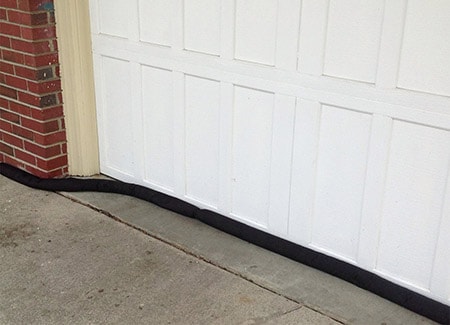
Here’s a final option. Out of everything on the list, this one is the closest to traditional sandbags because it does use sand. It’s affordable, reuseable, and gives you a little more versatility and control than typical sandbags.
These are meant for situations where you’ve just got a little bit of water to deal with. You could run it along the front of your garage door, around the drain in your basement, and so on.
If you’ve got a water leak or other plumbing issue in your home, these can help keep the water in place while you fix the cause. They’re not meant for any type of heavy-duty applications, and they won’t block the water as much as any of the other options I’ve talked about today, but they’re still an alternative to the typical sandbag.
Since they’re very narrow and thin, they don’t stop a ton of water, but that also makes them easier to work with at times where having a few dozen regular sandbags just isn’t as practical, and won’t do as good of a job for smaller amounts of water.
Which Sandbag Alternative Is Best?
There you have it, an in-depth look at some of the most popular and the best sandbag alternatives. Keep in mind that none of these are meant to stay in place forever, these are alternatives to sandbags for temporary flooding protection.
If you’re dealing with a permanent source of water, you’ll want to seek a more permanent solution.
Choosing the right one really comes down to deciding how much you want to spend on it, and how much water there is, and what you’re trying to protect.
The Snake Sandbags are great to have around the outside of your home if there are problem areas, it’s enough to stop rainwater from pooling as much, but it won’t do much against a serious flood.
Hopefully, I’ve given you enough information about each of these sandbag alternatives to help you with your continued research, and I hope you’re able to get your flood issues taken care of. Best of luck!



